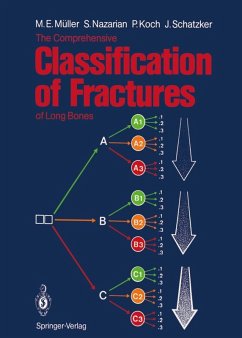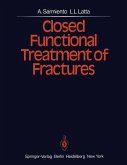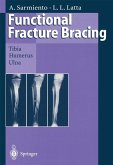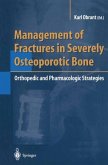Maurice E. Müller, Serge Nazarian, Peter Koch, Joseph Schatzker
The Comprehensive Classification of Fractures of Long Bones (eBook, PDF)
40,95 €
40,95 €
inkl. MwSt.
Sofort per Download lieferbar

20 °P sammeln
40,95 €
Als Download kaufen

40,95 €
inkl. MwSt.
Sofort per Download lieferbar

20 °P sammeln
Jetzt verschenken
Alle Infos zum eBook verschenken
40,95 €
inkl. MwSt.
Sofort per Download lieferbar
Alle Infos zum eBook verschenken

20 °P sammeln
Maurice E. Müller, Serge Nazarian, Peter Koch, Joseph Schatzker
The Comprehensive Classification of Fractures of Long Bones (eBook, PDF)
- Format: PDF
- Merkliste
- Auf die Merkliste
- Bewerten Bewerten
- Teilen
- Produkt teilen
- Produkterinnerung
- Produkterinnerung

Bitte loggen Sie sich zunächst in Ihr Kundenkonto ein oder registrieren Sie sich bei
bücher.de, um das eBook-Abo tolino select nutzen zu können.
Hier können Sie sich einloggen
Hier können Sie sich einloggen
Sie sind bereits eingeloggt. Klicken Sie auf 2. tolino select Abo, um fortzufahren.

Bitte loggen Sie sich zunächst in Ihr Kundenkonto ein oder registrieren Sie sich bei bücher.de, um das eBook-Abo tolino select nutzen zu können.
The AO classification system is an essential reference world-wide; this book gives the only authoritative guide to the AO classification of long-bone fractures.
- Geräte: PC
- ohne Kopierschutz
- eBook Hilfe
- Größe: 21.64MB
Andere Kunden interessierten sich auch für
![Treatment of Fractures in Children and Adolescents (eBook, PDF) Treatment of Fractures in Children and Adolescents (eBook, PDF)]() Treatment of Fractures in Children and Adolescents (eBook, PDF)62,95 €
Treatment of Fractures in Children and Adolescents (eBook, PDF)62,95 €![Frakturen (eBook, PDF) Frakturen (eBook, PDF)]() Christian Müller-MaiFrakturen (eBook, PDF)149,99 €
Christian Müller-MaiFrakturen (eBook, PDF)149,99 €![Closed Functional Treatment of Fractures (eBook, PDF) Closed Functional Treatment of Fractures (eBook, PDF)]() Augusto SarmientoClosed Functional Treatment of Fractures (eBook, PDF)62,95 €
Augusto SarmientoClosed Functional Treatment of Fractures (eBook, PDF)62,95 €![Functional Fracture Bracing (eBook, PDF) Functional Fracture Bracing (eBook, PDF)]() Augusto SarmientoFunctional Fracture Bracing (eBook, PDF)167,95 €
Augusto SarmientoFunctional Fracture Bracing (eBook, PDF)167,95 €![Management of Fractures in Severely Osteoporotic Bone (eBook, PDF) Management of Fractures in Severely Osteoporotic Bone (eBook, PDF)]() Management of Fractures in Severely Osteoporotic Bone (eBook, PDF)160,95 €
Management of Fractures in Severely Osteoporotic Bone (eBook, PDF)160,95 €![Frakturen auf einen Blick (eBook, PDF) Frakturen auf einen Blick (eBook, PDF)]() Frakturen auf einen Blick (eBook, PDF)66,99 €
Frakturen auf einen Blick (eBook, PDF)66,99 €![Reconstructive Surgery of the Long Bones with Autogenous and Homogenous Grafts (eBook, PDF) Reconstructive Surgery of the Long Bones with Autogenous and Homogenous Grafts (eBook, PDF)]() O. VerbeekReconstructive Surgery of the Long Bones with Autogenous and Homogenous Grafts (eBook, PDF)40,95 €
O. VerbeekReconstructive Surgery of the Long Bones with Autogenous and Homogenous Grafts (eBook, PDF)40,95 €-
-
-
The AO classification system is an essential reference world-wide; this book gives the only authoritative guide to the AO classification of long-bone fractures.
Dieser Download kann aus rechtlichen Gründen nur mit Rechnungsadresse in A, B, BG, CY, CZ, D, DK, EW, E, FIN, F, GR, HR, H, IRL, I, LT, L, LR, M, NL, PL, P, R, S, SLO, SK ausgeliefert werden.
Produktdetails
- Produktdetails
- Verlag: Springer Berlin Heidelberg
- Seitenzahl: 202
- Erscheinungstermin: 6. Dezember 2012
- Englisch
- ISBN-13: 9783642612619
- Artikelnr.: 53385493
- Verlag: Springer Berlin Heidelberg
- Seitenzahl: 202
- Erscheinungstermin: 6. Dezember 2012
- Englisch
- ISBN-13: 9783642612619
- Artikelnr.: 53385493
- Herstellerkennzeichnung Die Herstellerinformationen sind derzeit nicht verfügbar.
General Section.- 1. Principles of the Classification of Fractures.- 1.1 Morphological Characterization of a Fracture.- 1.2 The Location.- 1.3 Alpha-numeric Coding of the Diagnosis of a Fracture.- 2. The Long Bones, General Comments.- 2.1 Coding of the Long Bones.- 2.2 The Determination of the Segments of the Long Bones and of the Center of a Fracture.- 2.3 The Classification of Diaphyseal Fractures.- 2.3.1 The Diaphyseal Fracture Types.- 2.3.2 The Groups of the Diaphyseal Fractures of the Humerus, Femur, and Tibia/Fibula.- 2.3.3 The Groups of the Diaphyseal Fractures of the Radius/Ulna.- 2.3.4 A Comparative Analysis of 2700 Surgically Treated Diaphyseal Fractures.- 2.3.5 The Subgroups .1, .2, and .3 of the Diaphyseal Groups Al, A21, A3, and B1, B2, B3.- 2.3.6 The Subgroups .1, .2, and .3 of the Diaphyseal Groups Cl, C2, C3.- 2.3.7 The Qualifications for the Diaphyseal Subgroups.- 2.4 The Classification of Fractures of the Proximal and Distal Segments.- 2.4.1 The Fracture Types of Segments 13- and 33-, 21- and 41-, 23- and 43-.- 2.4.2 The Fracture Types for the Segments 11- and 31-.- 2.4.3 The Fracture Types for the Segment 44-.- 2.4.4 The Groups Al, A2, A3 of the Segments 13-, 21- and 23-, 33-, 41- and 43-.- 2.4.5 The Groups B1, B2, B3 of the Segments 13-, 21-, 23-, 33-, 41-, and 43-.- 2.4.6 The Groups Cl, C2, C3 of the Segments 13-, 21- and 23-, 33-, 41- and 43-.- 2.4.7 The Nine Groups Al to C3 of the Proximal Humerus = Segment 11-.- 2.4.8 The Nine Groups Al to C3 of the Proximal Femur = Segment 31-.- 2.4.9 The Avulsion Fractures of the Proximal and Distal Segments.- Special Section, Long Bones.- 1. Humerus = 1.- 1.1 Humerus, Proximal Segment = 11-.- 1.1.1 The Types.- 1.1.2 The Groups.- 1.1.3 The Subgroups and Their Qualifications.- 1.2 Humerus, Diaphyseal Segment = 12-.- 1.2.1 The Types.- 1.2.2 The Groups.- 1.2.3 The Subgroups and Their Qualifications.- 1.3 Humerus, Distal Segment = 13-.- 1.3.1 The Types.- 1.3.2 The Groups.- 1.3.3 The Subgroups and Their Qualifications.- 1.3.4 Comments.- 2. Radius/Ulna = 2.- 2.1 Radius/Ulna, Proximal Segment = 21-.- 2.1.1 The Types.- 2.1.2 The Groups.- 2.1.3 The Subgroups and Their Qualifications.- 2.2 Radius/Ulna, Diaphyseal Segment = 22-.- 2.2.1 The Types.- 2.2.2 The Groups.- 2.2.3 The Subgroups and Their Qualifications.- 2.3 Radius/Ulna, Distal Segment = 23-.- 2.3.1 The Types.- 2.3.2 The Groups.- 2.3.3 The Subgroups and Their Qualifications.- 3. Femur = 3.- 3.1 Femur, Proximal Segment = 31-.- 3.1.1 The Types.- 3.1.2 The Groups.- 3.1.3 The Subgroups and Their Qualifications.- 3.1.4 Comments.- 3.2 Femur, Diaphyseal Segment = 32-.- 3.2.1 The Types.- 3.2.2 The Groups.- 3.2.3 The Subgroups and Their Qualifications.- 3.3 Femur, Distal Segment = 33-.- 3.3.1 The Types.- 3.3.2 The Groups.- 3.3.3 The Subgroups and Their Qualifications.- 4. Tibia/Fibula = 4.- 4.1 Tibia/Fibula, Proximal Segment = 41-.- 4.1.1 The Types.- 4.1.2 The Groups.- 4.1.3 The Subgroups and Their Qualifications.- 4.2 Tibia/Fibula, Diaphyseal Segment = 42-.- 4.2.1 The Types.- 4.2.2 The Groups.- 4.2.3 The Subgroups and Their Qualifications.- 4.2.4 Comments.- 4.3 Tibia/Fibula, Distal Segment = 43-.- 4.3.1 The Types.- 4.3.2 The Groups.- 4.3.3 The Subgroups and Their Qualifications.- 4.4 Tibia/Fibula, Malleolar Segment = 44-.- 4.4.1 The Types.- 4.4.2 The Groups.- 4.4.3 The Subgroups and Their Qualifications.- 4.4.4 Comments about Malleolar Fractures.- Glossary = Dictionary.
General Section.- 1. Principles of the Classification of Fractures.- 1.1 Morphological Characterization of a Fracture.- 1.2 The Location.- 1.3 Alpha-numeric Coding of the Diagnosis of a Fracture.- 2. The Long Bones, General Comments.- 2.1 Coding of the Long Bones.- 2.2 The Determination of the Segments of the Long Bones and of the Center of a Fracture.- 2.3 The Classification of Diaphyseal Fractures.- 2.3.1 The Diaphyseal Fracture Types.- 2.3.2 The Groups of the Diaphyseal Fractures of the Humerus, Femur, and Tibia/Fibula.- 2.3.3 The Groups of the Diaphyseal Fractures of the Radius/Ulna.- 2.3.4 A Comparative Analysis of 2700 Surgically Treated Diaphyseal Fractures.- 2.3.5 The Subgroups .1, .2, and .3 of the Diaphyseal Groups Al, A21, A3, and B1, B2, B3.- 2.3.6 The Subgroups .1, .2, and .3 of the Diaphyseal Groups Cl, C2, C3.- 2.3.7 The Qualifications for the Diaphyseal Subgroups.- 2.4 The Classification of Fractures of the Proximal and Distal Segments.- 2.4.1 The Fracture Types of Segments 13- and 33-, 21- and 41-, 23- and 43-.- 2.4.2 The Fracture Types for the Segments 11- and 31-.- 2.4.3 The Fracture Types for the Segment 44-.- 2.4.4 The Groups Al, A2, A3 of the Segments 13-, 21- and 23-, 33-, 41- and 43-.- 2.4.5 The Groups B1, B2, B3 of the Segments 13-, 21-, 23-, 33-, 41-, and 43-.- 2.4.6 The Groups Cl, C2, C3 of the Segments 13-, 21- and 23-, 33-, 41- and 43-.- 2.4.7 The Nine Groups Al to C3 of the Proximal Humerus = Segment 11-.- 2.4.8 The Nine Groups Al to C3 of the Proximal Femur = Segment 31-.- 2.4.9 The Avulsion Fractures of the Proximal and Distal Segments.- Special Section, Long Bones.- 1. Humerus = 1.- 1.1 Humerus, Proximal Segment = 11-.- 1.1.1 The Types.- 1.1.2 The Groups.- 1.1.3 The Subgroups and Their Qualifications.- 1.2 Humerus, Diaphyseal Segment = 12-.- 1.2.1 The Types.- 1.2.2 The Groups.- 1.2.3 The Subgroups and Their Qualifications.- 1.3 Humerus, Distal Segment = 13-.- 1.3.1 The Types.- 1.3.2 The Groups.- 1.3.3 The Subgroups and Their Qualifications.- 1.3.4 Comments.- 2. Radius/Ulna = 2.- 2.1 Radius/Ulna, Proximal Segment = 21-.- 2.1.1 The Types.- 2.1.2 The Groups.- 2.1.3 The Subgroups and Their Qualifications.- 2.2 Radius/Ulna, Diaphyseal Segment = 22-.- 2.2.1 The Types.- 2.2.2 The Groups.- 2.2.3 The Subgroups and Their Qualifications.- 2.3 Radius/Ulna, Distal Segment = 23-.- 2.3.1 The Types.- 2.3.2 The Groups.- 2.3.3 The Subgroups and Their Qualifications.- 3. Femur = 3.- 3.1 Femur, Proximal Segment = 31-.- 3.1.1 The Types.- 3.1.2 The Groups.- 3.1.3 The Subgroups and Their Qualifications.- 3.1.4 Comments.- 3.2 Femur, Diaphyseal Segment = 32-.- 3.2.1 The Types.- 3.2.2 The Groups.- 3.2.3 The Subgroups and Their Qualifications.- 3.3 Femur, Distal Segment = 33-.- 3.3.1 The Types.- 3.3.2 The Groups.- 3.3.3 The Subgroups and Their Qualifications.- 4. Tibia/Fibula = 4.- 4.1 Tibia/Fibula, Proximal Segment = 41-.- 4.1.1 The Types.- 4.1.2 The Groups.- 4.1.3 The Subgroups and Their Qualifications.- 4.2 Tibia/Fibula, Diaphyseal Segment = 42-.- 4.2.1 The Types.- 4.2.2 The Groups.- 4.2.3 The Subgroups and Their Qualifications.- 4.2.4 Comments.- 4.3 Tibia/Fibula, Distal Segment = 43-.- 4.3.1 The Types.- 4.3.2 The Groups.- 4.3.3 The Subgroups and Their Qualifications.- 4.4 Tibia/Fibula, Malleolar Segment = 44-.- 4.4.1 The Types.- 4.4.2 The Groups.- 4.4.3 The Subgroups and Their Qualifications.- 4.4.4 Comments about Malleolar Fractures.- Glossary = Dictionary.







